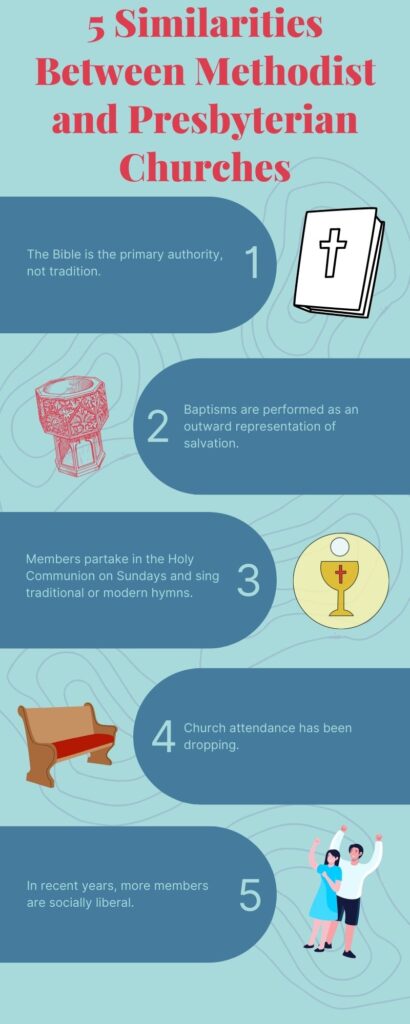
Centuries ago, the Christian faith was evolving into a multitude of denominations following the life and death of Jesus Christ. The main three branches are Eastern Orthodox, Catholicism, and Protestantism.
Two specific denominations spiral off the web of Protestantism: Methodism and Presbyterianism. Methodists and Presbyterians have differences, which you will explore below.
Presbyterian and Methodist beliefs both include the sovereignty of God, the authority of the Bible, and grace and salvation through faith. The two denominations differ in their opinions of sanctification (making yourself holy), atonement, and historical roots.
These two faiths have many differences, but they share some commonalities. Keep reading to learn them all!
Methodist vs. Presbyterian Comparison
These two denominations are Protestant religions. Protestantism holds that salvation comes from God’s grace through faith and not good deeds, that all believers are responsible for sharing the gospel of Jesus Christ, and that the Bible is the ultimate source of truth.
Origin Stories and Essential Characteristics:
| Topic | Methodist | Presbyterian |
|---|---|---|
| Branch of Christianity | Protestant | Protestant |
| History | The principal founder was British theologian John Wesley. Charles Wesley and George Whitefield were two other theologians that contributed to Methodism’s founding. Methodism is a newer denomination than Presbyterianism, starting in the 18th century. | The Presbyterian church has its roots grounded in the Church of Scotland and English Dissenter groups, dating back to the 16th century. It’s part of the Reformed church, also known as Calvinism, a branch of Protestantism that follows theologist John Calvin’s teachings. The Reformed movement is known for preaching God’s sovereignty and scriptural authority. |
| Etymology | The name “Methodist” comes from the word “methodical.” The founders wanted to portray that their denomination was known for the systematic way they practiced their faith. Methodism officially became a denomination after John Wesley’s death on March 2nd, 1791. | Did you know that the lower-case “presbyterian” and upper-case “Presbyterian” have different meanings? When capitalized, it refers explicitly to the Presbyterian church discussed in this article. When lowercase, it refers to the organization of church governance run by “presbyters” or elders. |
| Doctrine Essentials | What’s so special about Methodism? The basis of their faith is Wesleyan theology. It emphasizes sanctification (becoming holy) and highlights how faith can transform the believer’s character. | Presbyterian church doctrine is best known for Reformed theology (sovereignty of God and authority of the Bible) and the importance of receiving grace through faith in Jesus Christ. |
MORE:
- What is Lokai Bracelet?
- Mahamrityunjaya Mantra
- Mal De Ojo Bracelet Meaning
- Manifest Desires By Writing
- Manifestation
Similarities Between Methodists and Presbyterians
These two denominations have some similarities. Some Presbyterian churches have even formed unions with Methodist churches. They share threads of the same ornate rug that makes up the Christian faith and, more specifically, Protestantism.
They both believe that scripture (the Bible) is the primary authority rather than tradition or culture. They both use “confessions of faith” and sing hymns in their church services, which they hold on Sundays. The two sacraments upheld by each are baptism and Holy Communion.

Church attendance in the United States is dropping yearly, and Methodists and Presbyterians feel this decline. Both denominations also have undergone trends toward liberalism in practices and beliefs in recent years.
Doctrinal liberalism found in each denomination includes the ordination of women, confidence in Darwinian evolution, and accepting or granting same-sex marriage.
Social liberalism is also trending upward in both denominations. Both churches have increasing attendance of members whose political ideologies are liberal rather than conservative, as has been the case previously. Such issues include social justice, immigration, taxation, and abortion.
Differences Between Methodists and Presbyterians
You’ve learned the basics of each denomination. Now, it’s time to find out the differences in their specific beliefs and practices.
Methodist Beliefs and Practices
In Methodism, salvation is considered available to all. Practices of the faith include evangelism and charity work for the sick and poor. These practices occur because Methodists believe God commands them to spread the gospel and serve humanity.
In addition to following the authority of the Bible, they adhere to traditional creeds, which are “statements of faith.” The way Methodists worship varies from highly ritualistic to less ritualistic. The United Methodist Church in America, in particular, is more ceremonial than most Methodist churches.
They practice “tent revivals,” camps set up for evangelical purposes. This denomination is also known for its robust musical culture. One early church leader, Charles Wesley, wrote most of the hymns they sing today. In this denomination’s melodies, you’ll find teachings of holiness, charity, and personal commitment to the principles mentioned above, which Presbyterians have traditionally used in their evangelical efforts.
Methodists are known to follow the doctrine of not conforming to the world. New Testament scriptural verses contain this doctrine. Historically, church standards included avoiding drinking alcohol, abstaining from gambling, and attending all church meetings regularly.
Methodists accept the Apostle’s Creed and the Nicene Creed, universal creeds for the Christian faith. They believe in the Godhead, which contains the Father, the Son, and the Holy Spirit. They believe Jesus Christ to be both fully divine and fully human.
Members of the Methodist church use the Holy Spirit as a transformative power to increase faith and reform character. An essential trait is practicing Christian holiness. That is, to love God deeply and to love other people.
Presbyterian Beliefs and Practices
In Presbyterianism, God pre-ordained salvation, meaning it’s not available to all. This idea comes from Reformism, known as Calvinism, as mentioned earlier. Notably, some Methodists, called Calvinist Methodists, believe in pre-ordained salvation.
Presbyterian churches have ranging levels of following the confessions of faith. Consequently, the standards of doctrine differ across churches regarding authority, content, and practical decisions based on these confessions.
Further, a uniform worship style doesn’t bind this denomination, but they do adhere to holding weekly services on Sunday, the Lord’s Day. The two Sacraments they believe in are baptism and the Lord’s Supper (communion).
Lastly, Presbyterians believe in the “priesthood of all believers,” meaning all church members are responsible for sharing the gospel of Jesus Christ with the world. Either men or women govern all levels of the church.
Infographic of U.S. Denominations / Membership
As you now understand, these two faiths share significant similarities since they’re both Protestant branches. Despite the differences between Methodists and Presbyterians, the two faiths have stood side by side for centuries and even work together today. Only time will tell what the future holds as each denomination continues to evolve in practices, beliefs, and member composition.
MORE:
- Ringing In Ears
- Roman Catholic vs. Lutheran
- Roman Gods & Goddesses
- Salvation
- Affirmations for Self-Love
